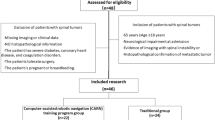Abstract
Introduction
The cervical screw placement is one of the most difficult procedures in spine surgery, which often needs a long period of repeated practices and could cause screw placement-related complications. We performed this cadaver study to investigate the effectiveness of virtual surgical training system (VSTS) on cervical pedicle screw instrumentation for residents.
Materials and methods
A total of ten novice residents were randomly assigned to two groups: the simulation training (ST) group (n = 5) and control group (n = 5). The ST group received a surgical training of cervical pedicle screw placement on VSTS and the control group was given an introductory teaching session before cadaver test. Ten fresh adult spine specimens including 6 males and 4 females were collected, and were randomly allocated to the two groups. The bilateral C3–C6 pedicle screw instrumentation was performed in the specimens of the two groups, respectively. After instrumentation, screw positions of the two groups were evaluated by image examinations.
Results
There was significantly statistical difference in screw penetration rates between the ST (10%) and control group (62.5%, P < 0.05). The acceptable rates of screws were 100 and 50% in the ST and control groups with significant difference between each other (P < 0.05). In addition, the average screw penetration distance in the ST group (1.12 ± 0.47 mm) was significantly lower than the control group (2.08 ± 0.39 mm, P < 0.05).
Conclusions
This study demonstrated that the VSTS as an advanced training tool exhibited promising effects on improving performance of novice residents in cervical pedicle screw placement compared with the traditional teaching methods.





Similar content being viewed by others
References
Kim YJ, Lenke LG, Kim J et al (2006) Comparative analysis of pedicle screw versus hybrid instrumentation in posterior spinal fusion of adolescent idiopathic scoliosis. Spine 31:291–298
Ebraheim NA, Xu R, Ahmad M et al (1977) Projection of the thoracic pedicle and its morphometric analysis. Spine 22:233–238
Lonstein JE, Denis F, Perra JH et al (1999) Complications associated with pedicle screws. J Bone Joint Surg Am 81:1519–1528
Gelalis ID, Paschos NK, Pakos EE et al (2012) Accuracy of pedicle screw placement: a systematic review of prospective in vivo studies comparing free hand, uroscopy guidance and navigation techniques. Eur Spine J 21:247–255
Gautschi OP, Schatlo B, Schaller K et al (2011) Clinically relevant complications related to pedicle screw placement in thoracolumbar surgery and their management: a literature review of 35,630 pedicle screws. Neurosurg Focus 31:E8
Lee GY, Massicotte EM, Rampersaud YR (2007) Clinical accuracy of cervicothoracic pedicle screw placement: a comparison of the “open” lamino-foraminotomy and computer-assisted techniques. J Spinal Disord Tech 20:25–32
Ludwig SC, Kramer DL, Balderston RA et al (2000) Placement of pedicle screws in the human cadaveric cervical spine: comparison accuracy of three techniques. Spine 25:1655–1667
Sakai Y, Matsuyama Y, Nakamura H et al (2008) Segmental pedicle screwing for idiopathic scolliosis using computed-assisted surgery. J Spinal Disord Tech 21:181–186
Mohamed M, Eldin M (2014) Cervical pedicle screw fixation: anatomic feasibility of pedicle morphology and radiologic evaluation of the anatomical measurements. Asian Spine J 8:273–280
Cong Y, Bao N, Zhao J (2015) Comparing accuracy of cervical pedicle screw placement between a guidance system and manual manipulation: a cadaver study. Med Sci Monit 21:2672–2677
Shimokawa N, Takami T (2017) Surgical safety of cervical pedicle screw placement with computer navigation system. Neurosurg Rev 40:251–258
Lee DH, Lee SW, Kang SJ et al (2011) Optimal entry points and trajectories for cervical pedicle screw placement into subaxial cervical vertebrae. Eur Spine J 20:905–911
Uehara M, Takahashi J, Ogihara N et al (2012) Cervical pedicle screw fixation combined with laminoplasty for cervical spondylotic myelopathy with instability. Asian Spine J 6:241–248
Abumi K (2015) Cervical spondylotic myelopathy: posterior decompression and pedicle screw fixation. Eur Spine J 24(Suppl 2):186–196
Karhade AV, Vasudeva VS, Pompeu YA et al (2016) Image guided spine surgery: available technology and future potential. Austin Neurosurg Open Access 3:1043
Badash I, Burtt K, Solorzano CA et al (2016) Innovations in surgery simulation: a review of past, current and future techniques. Ann Transl Med 4:453
Harrop J, Rezai AR, Hoh DJ et al (2013) Neurosurgical training with a novel cervical spine simulator: posterior foraminotomy and laminectomy. Neurosurgery 73(Suppl 1):94–99
Gottschalk MB, Yoon ST, Park DK et al (2015) Surgical training using three-dimensional simulation in placement of cervical lateral mass screws: a blinded randomized control trial. Spine J 15:168–175
Funding
This work was supported by the National Natural Science Foundation of China (Grant Nos. 81372017 and 51575343); Shanghai Natural Science Fund (Grant No. 17ZR1447600); Shanghai Education Science Research Project (Grant No. C160078).
Author information
Authors and Affiliations
Corresponding author
Ethics declarations
Ethical approval
All procedures performed in studies involving human participants were in accordance with the ethical standards of the institutional and/or national research committee and with the 1964 Helsinki declaration and its later amendments or comparable ethical standards.
Additional information
Jiangang Shi, Yang Hou and Yanping Lin contributed equally to this study and should be considered as co-first authors.
Rights and permissions
About this article
Cite this article
Hou, Y., Shi, J., Lin, Y. et al. Virtual surgery simulation versus traditional approaches in training of residents in cervical pedicle screw placement. Arch Orthop Trauma Surg 138, 777–782 (2018). https://doi.org/10.1007/s00402-018-2906-0
Received:
Published:
Issue Date:
DOI: https://doi.org/10.1007/s00402-018-2906-0




